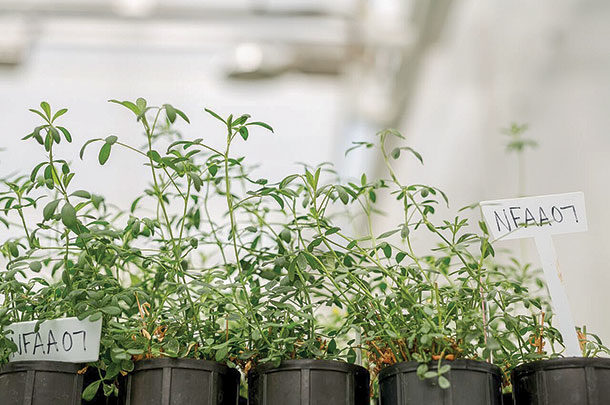Some of the newest fields of science are biological fields of study described by words that end in “omics.” Probably the one heard most often is genomics, but there are also transcriptomics, proteomics and metabolomics, to name a few more. The objects of these fields of study will end in the suffix “ome.”
The suffix “ome” in biology means “in total” or “in whole.” So when we say “alfalfa genome research,” it would refer to the genomics field of biological science that studies the genome of alfalfa.
The genome is the complete set of genes inside a cell or, very simply in the case of alfalfa, the genetic material that makes up alfalfa. Currently, there is a large effort to sequence the alfalfa genome. This means to try and figure out in what order the nucleotides – adenine (A), guanine (G), thymine (T) and cytosine (C) – occur in the alfalfa DNA.
A DNA sequence within the alfalfa genome might look like this: ATGCCAGGTGCT. Basically, it is a code. Sequencing the genome is the first step toward a deeper understanding of how an organism functions.
Once a genome is sequenced, scientists must then work to “break” the code in order to understand the meaning of the code, such as how the genes making up the code function, what they control and how they work together.
Alfalfa typically ranks fourth in U.S. crop value, behind corn, soybeans and wheat. Combine crop value with its agronomic traits of high production, high nutritive value, little or no requirement for nitrogen fertilizer, and then alfalfa becomes a very attractive crop to producers.
While alfalfa is often called the queen of forages, it has its drawbacks. Among these is the potential to cause bloat in ruminant animals, susceptibility to root disease and insect depredation, and sensitivity to soil pH. These drawbacks increase the management requirements for alfalfa and limit its production potential in some areas of the country.
Plant breeders can overcome some of these drawbacks through selective breeding, but the process from initial plant selection to variety release is often slow, tedious and frustrating.
But what if a plant breeder had a source of knowledge to go to? What if they could grab a certain trait they want to improve upon in alfalfa and place it into the germplasm, thereby producing an improved variety in a shorter period of time? It could lead to hardier, more productive and profitable varieties over time.
By first sequencing the alfalfa genome, then decoding the sequences, scientists can begin to locate genes that can control traits of interest such as disease resistance, nutritive value, yield or plant persistence. By knowing which genes control a certain trait, plant breeders can then make quicker progress in breeding plants with desired traits because they know what they are looking for.
However, this is no easy task. The alfalfa genome size is 800 to 900 million base pairs. Sequencing the alfalfa genome began in 2011. Most of the alfalfa genome has now been sequenced by scientists at the Samuel Roberts Noble Foundation, University of Minnesota and the National Center for Genome Resources.
The scientists working on this endeavor hope to have the remaining unsequenced portion of the genome completed soon.
Once completed, the alfalfa genome will become part of the alfalfa breeder’s toolbox, which will be housed at the Noble Foundation in Ardmore, Oklahoma. Much like the toolbox in your shop that houses all the tools needed to build something, the breeder’s toolbox will house publicly available tools an alfalfa breeder would need in order to build a better alfalfa.
Alfalfa has many desirable traits that make it the queen of forages, but for many producers the ability to grow alfalfa may currently be out of reach due to limitations related to soil, temperature, insects or other factors.
Plant breeders, through the sequencing of the alfalfa genome and other tools that become available in the breeder’s toolbox, will be able to work toward breeding alfalfa varieties that will overcome these limitations and expand the use of alfalfa nationwide. ![]()
PHOTO: By sequencing and decoding alfalfa genomes, researchers can locate the genes that control specific traits. This accelerates new trait development. Photo courtesy of The Samuel Roberts Noble Foundation.

-
James Rogers, Ph.D.
- Assistant Professor
- Noble Foundation
- Email James Rogers, Ph.D.












